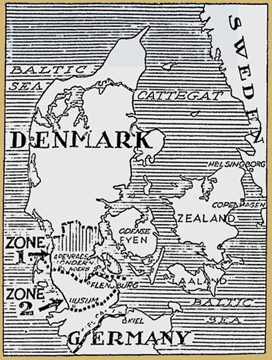Schleswig
Schleswig Plebiscite Issue

After Germany's defeat in World War I, plebiscites were held in the northern part of the former province of Schleswig-Holstein to determine whether it would be united with Denmark or would remain a part of Germany. On January 25 1920 a set of 14 definitives (denominated in pfennig and marks) depicting the arms of Schleswig on the lower values and a view of Schleswig on the higher denominations. On May 20 the set was overprinted for Zone 1 with denominations in Danish ore and krone. The original set was also overprinted "C.I.S." (Commission Interalliée Slesvig) for official use.

Sketch map of Plebiscite Zones from The Ottawa Citizen, February 18, 1920.
On February 18, 1920, The Ottawa Citizen reported on the results of the plebiscite in Zone I:
Denmark will get an addition to her population of 223,000 people as a result of the plebiscite held in Zone I of northern Schleswig under the terms of the peace treaty. The people of this zone voted 75,000 for Danish sovereignty to 25,000 for German. The plebiscite was held under the terms of the peace treaty. A plebiscite in Zone II will be held on March 14. The territory was taken by Germany in 1864. The people were promised a plebiscite, but Germany has always refused it.
An area of 1,050 square miles becomes Danish by the addition of Zone I to Denmark. Of this, 57 per cent is tilled, 22 per cent. is in meadows and 7 per cent. in forests. On the east and west coasts are rich agricultural lands, with alluvial marsh lands on the west.
Three important ports, Haderplev, Apenrade and Sonderburg on the Baltic coast go to Denmark. On the west coast the land is marshy and protected by dikes in the same way that Holland is protected. Here the fishing industry and the oyster beds are valuable.
The "first zone” produces grain, cattle, horses, fish and oysters. There are no mines or canals in any part of Schleswig, but the new territory is a veritable network of railroads, built by Germany for war purposes. Two main lines run along the east and west coasts 30 miles long.
Zone II voted to remain with Germany and its main town, Flensburg, was, for a brief time, the final seat of government for Germany's fascist administration after Hitler's death.
Bibliography
"Plebiscite Sends Population of Denmark Soaring." The Ottawa Citizen. 18 Feb. 1920: 2.
"Schleswig." Standard Postage Stamp Catalogue. 2008.
Direct comments, questions and corrections to:
stampquestions@hotmail.com
© Grose Educational Media, 2015
|